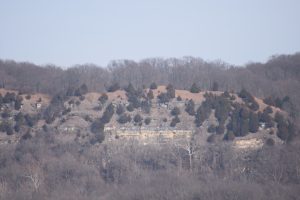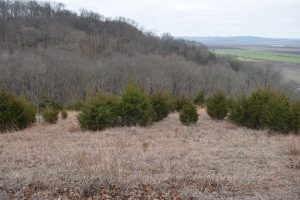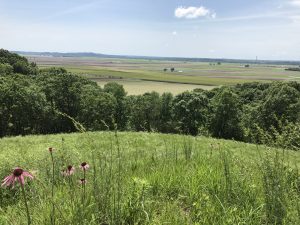The Pros and Cons of the Eastern Red Cedar
The name Eastern Red Cedar is a misnomer. This tree is actually a juniper, as its botanical name (Juniperus virginiana) indicates. It is native to Illinois, yet it can be considered a nuisance or even an invasive.
Eastern red cedars have long been used as Christmas trees because of their abundance and lovely fragrance despite the prickly leaves which make it difficult to decorate. The dense branches of the eastern red cedar provide important refuge and shelter for song birds and game birds. Turkeys are known to take refuge from a rainstorm under its umbrella-like branches. Butterflies and small mammals also benefit from the cover this tree provides. Squirrels and other small mammals peel off the shaggy bark to use in their nest materials.
The berries are an important source of food for more than 50 bird species as well as a variety of mammal species, including rabbits, foxes, raccoons, skunks, opossums, and coyotes. The blue fruits on the female trees are consumed by a wide variety of wildlife, including the Cedar Waxwing songbird, which is named for this tree. The twigs and foliage are often eaten by hoofed browsers, such as whitetail deer. Deer also enjoy the soft cushion of fallen foliage under large trees to escape the intense heat of the summer sun as do certain reptiles.
Because the heartwood is rot resistant, eastern red cedars are prized for building purposes such as outdoor furniture, gazebos, decks and fences. It is famously known for its fragrant oil, which is a natural insect repellant. Because the scent repels moths, the aromatic wood has been used for centuries in the construction of chests, closets, and wardrobes to protect woolen clothing. Red cedar sawdust or wood chips may also be used in kennel bedding to repel fleas and minimize odors. Yet, can you imagine trying to retrieve these trees from the bluff lands in our area?
If you are looking for a tree to create a windbreak, eastern red cedar is a good choice. It is resistant to extremes of drought, heat and cold. It is tolerant of a wide range of soils – poor dry soil or alkaline soil. It is also tolerant of salt, making it favorable for use near roads, driveways and sidewalks.

Despite the positives just cited, the eastern red cedar has its negative side, as well. This plant can potentially have a negative impact in some ecosystems if it is not managed well. And therein lies the dilemma. In the past, controlled fires kept the tree from populating open fields. As human populations increased and spread across the country, controlled fires became less desirable. One must only observe the bluff lands in our area to see the result of the lack of fire to control red cedars. When observed from a distance, the proliferation of cedar trees is obvious. Where there were once hill prairies, there is now a forest of cedars.

Fire, of course, is not the only way to control eastern red cedar trees. Pruning shears or loppers can easily cut through small trunks, while a chainsaw will take down larger trees. Fortunately, if you cut the tree below the lowest green branch it will not re-sprout, no herbicide stump treatment is needed. When stacked in a pile they burn quite readily.

According to the U.S. Fish and Wildlife Department, just one acre of eastern red cedars can suck up as much as 55,000 gallons of water per year from the surrounding area. Many properties are no longer aggressively managed, especially in the bluffs, resulting in conditions that are more ideal for the spread of this tree into hill prairies than in the past. At a minimum, the eastern red cedar can be a nuisance tree, particularly in open fields and hill prairies where young seedlings are not regularly mowed or managed in some way. Worst case, it has the capacity to negatively impact certain ecosystems by crowding out other native grass and forb species.
CLIFFTOP, a local nonprofit organization, is focused on preserving and protecting area bluff lands.
A version of this article appeared in the January 15, 2021 edition of the Monroe County Independent.
©2021 all content rights reserved Clifftop NFP.
Comments are currently closed.
